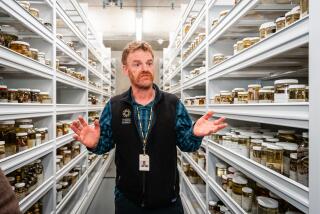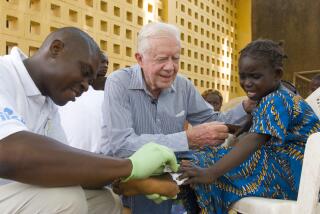World Health : Scientists Expect to Virtually Wipe Out 2 Illnesses by 2000
- Share via
Leprosy, one of humanity’s most ancient and feared scourges, can be virtually eliminated by the year 2000, and victory also is near in the battle against river blindness, which has affected millions in West Africa, the World Health Organization reports.
It said the two diseases will soon join smallpox and polio in the pantheon of once-widespread afflictions eradicated by aggressive vaccination and treatment programs.
“Eliminating leprosy as a public health problem is no longer a dream,” said Dr. Shaik K. Noordeen, chief of the U.N. agency’s leprosy unit in Geneva. “We have the know-how, the determination and the necessary network to achieve this.”
Dr. Ebrahim Samba, who heads the agency’s program against river blindness in Ouagadougou, Burkina Faso, added: “Some 30 million people in 11 countries are no longer at risk (of this illness), and millions of acres of river basin land have now been liberated from the disease and are being resettled. This land could feed an estimated 17 million additional people using traditional agricultural practices.”
In both cases, gains are being made using an aggressive chemotherapy program based on drugs that are inexpensive or, in the case of river blindness, free. The drugs, easily administered by even poorly trained health care workers, offer an appealing alternative to vaccination and insect-eradication programs, neither of which has proved effective in combatting the two problems.
Leprosy, also known as Hansen’s disease, is caused by a microorganism, Mycobacterium leprae , which is passed from person to person by transmission through the nose and throat. It enters the body discreetly, provoking no violent symptoms. It multiplies for years, infiltrating nerves and skin. Eventually, it destroys the nerves, producing paralysis, mutilation and disfigurement.
The U.N. agency estimates that 3.1 million people in 87 countries now have leprosy, with 600,000 more infected each year; 81% of the victims are in five countries--Brazil, India, Indonesia, Myanmar and Nigeria. The United States has about 6,000 cases, most among immigrants from affected areas.
The decrease resulted from the introduction of multi-drug therapy in the early 1980s. For 25 years before that, leprosy was treated effectively with the antibiotic dapsone until reliance on a single drug produced a high degree of resistance to it by the mycobacterium.
But researchers found that giving two other antibiotics, rifampicin and clofazimine--in conjunction with dapsone--eliminated this problem and provided an effective cure. The average cost of treatment: about $15 per patient.
Only about a third of leprosy patients now are being treated, Noordeen said. To get rid of leprosy will require that more than 85% of victims be treated, an effort that will cost $420 million over six years. The World Health Organization is now attempting to raise money for this “intensified” effort, he said. Its goal is to reduce the incidence of leprosy below one case per 10,000 people. At that level, he said, the mycobacteria “will simply die out.”
River blindness--or onchocerciasis--is caused by a parasitic worm, Onchocerca volvulus . The worm can grow to two feet in length inside the human body; each produces millions of microfilariae that cause intense itching, disfiguring skin changes, weight loss and blindness. The disease is transmitted person-to-person by the black fly, which breeds in fast-flowing rivers, such as the Volta in West Africa.
In 1988, the disease affected an estimated 18 million people, about 340,000 of whom were already blind. The disease forced entire communities to abandon fertile riverside homes and to resettle in less fertile areas, with resulting severe food shortages.
The breakthrough against the disease came with the discovery that ivermectin, a drug used to control parasites in cattle and heartworm in dogs, is highly effective against the river blindness worm. One tablet a year is sufficient, in most cases, to eradicate microfilariae from the body and halt symptoms. The drug has been donated to WHO since 1988 by its American manufacturer, Merck & Co.
More to Read
Sign up for Essential California
The most important California stories and recommendations in your inbox every morning.
You may occasionally receive promotional content from the Los Angeles Times.













